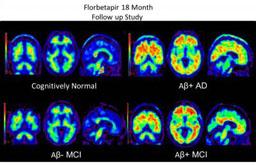
Greg Freiherr has reported on developments in radiology since 1983. He runs the consulting service, The Freiherr Group.
Global Warming and Alzheimer’s Disease

PET images produced using florbetapir, which highlights beta-amyloid plaques, show the brains of a cognitively normal subject (top left); an amyloid-positive patient with Alzheimers disease (top right); a patient with mild cognitive impairment (bottom left) and a patient with mild cognitive impairment who progressed to dementia during a multi-center 18-month study (bottom right). Image courtesy of the journal Neurology
When I was a kid, living in a mid-size Wisconsin town, my family would drive the mile or so from our home to the Lake Michigan shore to escape the occasional oppressive heat of summer. The deep lake waters cooled the air. The hour or two we spent at its shore on hot July and August days gave us the break we needed to face the rest of the day in our house.
My mind returned to that time after seeing a political cartoon dismissing those who blame the searing heat across our nation on global warming. “We used to call them heat waves,” said the tag line of the cartoon showing sweltering heat and a newspaper headline blaming global warming. That got me thinking.
When I was young, senility was a natural consequence of getting old. When science tried to change that way of thinking, Alzheimer’s disease was dismissed as “old timer’s” disease. It was medical imaging that turned the tide, visualizing a disease process that couldn’t previously be seen.
Positron emission tomography (PET) images show amyloid plaques accumulating in the brains of patients with Alzheimer’s disease. Research published earlier this month found that early detection of these plaques could help guide patient management and possibly the development of new therapies for patients with the disease (http://www.neurology.org/content/early/2012/07/11/WNL.0b013e3182661f74.short?rss=1). The researchers used a PET agent called florbetapir. Not long ago, the U.S. Food & Drug Administration (FDA) approved florbetapir, commercially dubbed Amyvid by its developer Eli Lilly, making it the first commercial imaging agent for visualizing amyloid plaques and, therefore, diagnosing Alzheimer’s disease.
The company, as seen in its FDA-approved labeling, is careful not to claim too much. A positive result using Amyvid “does not establish a diagnosis of Alzheimer’s disease,” according to the labeling. It can be used, however, to rule out other dementias, as only Alzheimer’s disease is associated with the presence of amyloid plaques. The distinction is a fine point, best appreciated in scientific circles, where the community arrives at and embraces new ideas only after taking a series of cautious steps.
So it is with global warming. What we once believed were heat waves may have been the early signs of global change, signs that were not recognized for what they were, just as senility was viewed as an inevitable part of life rather than a disease.
Medical imaging is providing visual evidence of the underlying disease process. The use of Amyvid and the rival drugs that follow in its wake – GE and Bayer are known to be working on similar products – will increase as reimbursement for their use becomes available.
Sure to make an even greater impact will be effective treatments for Alzheimer’s disease. Amyvid and other such agents may promote the development of such treatments. By providing the means for diagnosis, they make it easier to identify patient populations for testing experimental therapies, just as they may provide a baseline through the visualization of amyloid plaques for assessing the effectiveness of these therapies.
Future progress, therefore, depends on developing an understanding of the underlying problems that can only be gained through scientific progress, regardless of whether we are battling senility or heat waves. Understanding the complex factors involved can be confounding. But to dismiss efforts aimed at doing so – or worse yet, denying the presence of disease or environmental change – is self-defeating.


 December 10, 2025
December 10, 2025 









